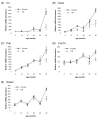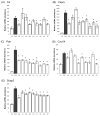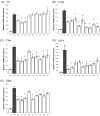Gene expression profiling of aging in multiple mouse strains: identification of aging biomarkers and impact of dietary antioxidants
- PMID: 19555370
- PMCID: PMC2733852
- DOI: 10.1111/j.1474-9726.2009.00496.x
Gene expression profiling of aging in multiple mouse strains: identification of aging biomarkers and impact of dietary antioxidants
Abstract
We used DNA microarrays to identify panels of transcriptional markers of aging that are differentially expressed in young (5 month) and old (25 month) mice of multiple inbred strains (129sv, BALB/c, CBA, DBA, B6, C3H and B6C3F(1)). In the heart, age-related changes of five genes were studied throughout the mouse lifespan: complement component 4, chemokine ligand 14, component of Sp100-rs, phenylalanine hydroxylase and src family associated phosphoprotein 2. A similar analysis in the brain (cerebellum) involved complement component 1q (alpha polypeptide), complement component 4, P lysozyme structural, glial fibrillary acidic protein and cathepsin S. Caloric restriction (CR) inhibited age-related expression of these genes in both tissues. Parametric analysis of gene set enrichment identified several biological processes that are induced with aging in multiple mouse strains. We also tested the ability of dietary antioxidants to oppose these transcriptional markers of aging. Lycopene, resveratrol, acetyl-l-carnitine and tempol were as effective as CR in the heart, and alpha-lipoic acid and coenzyme Q(10) were as effective as CR in the cerebellum. These findings suggest that transcriptional biomarkers of aging in mice can be used to estimate the efficacy of aging interventions on a tissue-specific basis.
Figures






References
-
- Akahoshi N, Murashima YL, Himi T, Ishizaki Y, Ishii I. Increased expression of the lysosomal protease cathepsin S in hippocampal microglia following kainate-induced seizures. Neurosci Lett. 2007;429:136–141. - PubMed
-
- Allison DB, Gadbury GL, Heo M, Fernandez JR, Lee CK, Prolla TA, Weindruch R. A mixture model approach for the analysis of microarray gene expression data. Comput Statist Data Anal. 2002;39:1–20.
-
- Barger JL, Kayo T, Pugh TD, Prolla TA, Weindruch R. Short-term consumption of a resveratrol-containing nutraceutical mixture mimics gene expression of long-term caloric restriction in mouse heart. Exp Gerontol. 2008;43:859–866. - PubMed
-
- Barger JL, Kayo T, Vann JM, Arias EB, Wang J, Hacker TA, Wang Y, Raederstorff D, Morrow JD, Leeuwenburgh C, Allison DB, Saupe KW, Cartee GD, Weindruch R, Prolla TA. A low dose of dietary resveratrol partially mimics caloric restriction and retards aging parameters in mice. PLoS One. 2008;3:e2264. - PMC - PubMed
-
- Barger JL, Walford RL, Weindruch R. The retardation of aging by caloric restriction: its significance in the transgenic era. Exp Gerontol. 2003;38:1343–1351. - PubMed
Publication types
MeSH terms
Substances
Grants and funding
LinkOut - more resources
Full Text Sources
Other Literature Sources
Medical
Miscellaneous

